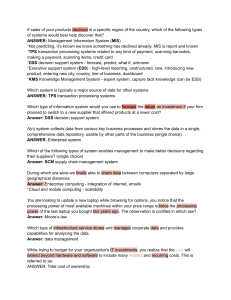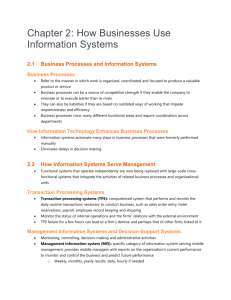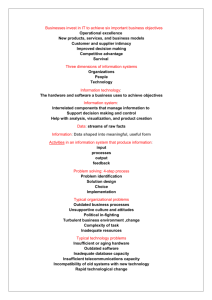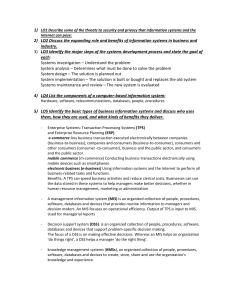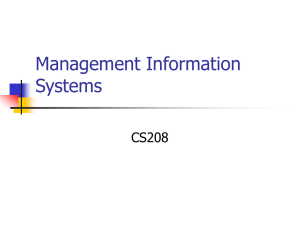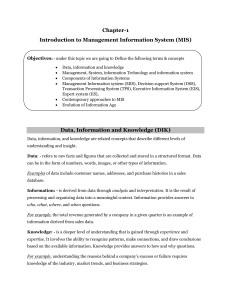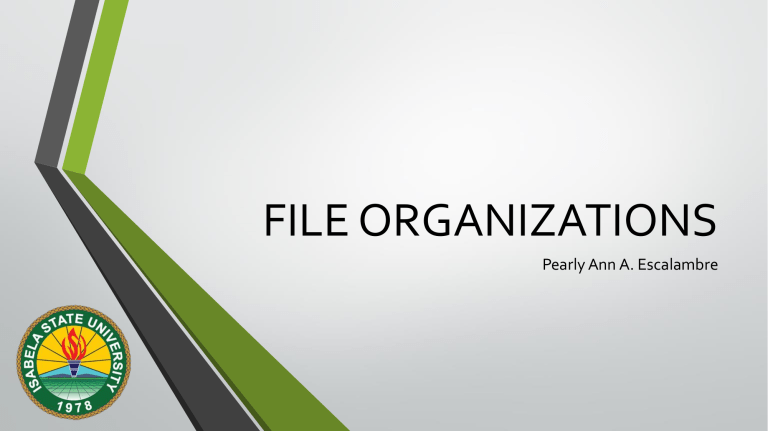
FILE ORGANIZATIONS Pearly Ann A. Escalambre Let’s have a Pre - Test! 1.) Information systems that monitor the elementary activities and transactions of the organizations are ________ . •A. Management level system •B. Operational level system •C. Knowledge level system •D. Strategic level system 2.) Projections and responses to queries are Information output characteristics associated with ________. A. Decision Support System (DSS) B. Management Information System (MIS) C. Executive Support System (ESS) D. Transaction Processing System (TPS) 3.) Summary transaction data, high-volume data, and simple models are information inputs characteristic of _________________. A. Decision Support System (DSS) B. Management Information System (MIS) C. Executive Support System (ESS) D. Transaction Processing System (TPS) 4.) Which of the following individuals typically have less formal, advanced educational degrees and tend to process rather than create information? A. Knowledge workers B. Executives C. System analysts D. Data workers 5.) Which of the following is the advantage of an Electronic Data Processing? A. Loss of data B. Unsecured system C. Fast up the structure D. Alphabetic codes can be descriptive Now that you have answered the Pre-Test as we go along, we will be learning the following topics in EDP. • File Organizations • Management level system • Operational level system • Knowledge level system • Strategic level system • Decision Support System (DSS) • Management Information System (MIS) • Executive Support System (ESS) • Transaction Processing System (TPS) • Knowledge workers • Executives • System analysts • Data workers File Organizers • File Organizer is advanced feature designed to group and rename files, using their system attributes or meta attributes, before actual recovery. Every file has system attributes like date (Accessed, Created and Modified), file type (defined by extension) and associated with that file type registered application. Management Level Systems •Management-level systems serve the monitoring, controlling, decisionmaking, and administrative activities of middle managers. Operational Level Systems • Operational-level systems support operational managers by keeping track or monitor the activities and transactions of the organization, such as sales, receipts, cash deposits, payroll, credit decisions, and the flow of materials in a factory. Knowledge Level Systems • The knowledge level is the rational basis for the behavior of a system using artificial intelligence. Known as agents, such systems need knowledge to make inferences about the world and take action in response to specific prompts. Strategic Level Systems • Strategic-level systems help senior management tackle and address strategic issues and long-term trends, both in the firm and in the external environment. Their principal concern is matching changes in the external environment with existing organizational capability. Decision Support Systems (DDS) • A decision support system (DSS) is a computer program application used to improve a company's decision-making capabilities. It analyzes large amounts of data and presents an organization with the best possible options available. Management Information System (MIS) • A management information system (MIS) is a computer system consisting of hardware and software that serves as the backbone of an organization's operations. An MIS gathers data from multiple online systems, analyzes the information, and reports data to aid in management decision-making.

